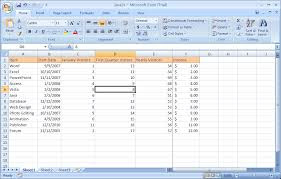Unlocking the Power of Advanced Excel: Tips and Techniques for Mastery
Excel has long been a staple in the world of data management and analysis, but its true potential often remains untapped by casual users. For those ready to dive deeper, mastering advanced Excel techniques can transform your data handling, enhance your productivity, and elevate your decision-making process. In this blog, we’ll explore some of the most powerful advanced Excel features and how they can be applied to elevate your data game.
1. Advanced Formulas: Beyond the Basics
While basic formulas like SUM and AVERAGE are familiar to most Excel users, advanced formulas can dramatically expand your capabilities:
- INDEX and MATCH: Often used together, INDEX and MATCH can replace VLOOKUP, providing more flexibility and efficiency. INDEX returns the value of a cell in a table based on the row and column numbers, while MATCH searches for a value in a range and returns its relative position.
=INDEX(A2:B10, MATCH("TargetValue", A2:A10, 0), 2)
- ARRAY Formulas: Array formulas perform multiple calculations on one or more items in an array. They are especially useful for complex operations like conditional calculations across ranges.
=SUM((A2:A10="Criteria") * (B2:B10))
To enter an array formula, use `CTRL+SHIFT+ENTER` (in older Excel versions) or simply enter in modern Excel versions.
2. Pivot Tables and Pivot Charts: Summarizing Data with Ease
Pivot Tables are powerful tools for summarizing and analyzing data:
- Creating Pivot Tables: Start by selecting your data range and choosing `Insert > PivotTable`. Drag and drop fields into rows, columns, values, and filters to create a customized summary of your data.
- Pivot Charts: Enhance your Pivot Table analysis with Pivot Charts. Select your Pivot Table and choose `Insert > PivotChart`. This visual representation helps in identifying trends and patterns more intuitively.
3. Power Query: Transform and Clean Data Efficiently
Power Query, accessible through `Data > Get & Transform Data`, allows you to connect to various data sources, clean, and transform data without altering the original dataset:
- Data Transformation: Use Power Query Editor to filter, sort, and aggregate data. You can also combine data from multiple sources, such as merging tables or appending queries.
- Automating Data Refreshes: Once you set up your query, you can refresh it to automatically update your data with the latest information.
4. Power Pivot: Advanced Data Modeling
Power Pivot is a data modeling tool that extends Excel’s capabilities by allowing you to create sophisticated data models:
- Data Relationships: Create relationships between tables to build a comprehensive model. This enables you to analyze data from multiple tables seamlessly.
- DAX (Data Analysis Expressions): DAX is a powerful formula language for creating custom calculations in Power Pivot. Examples include creating calculated columns or measures like Year-to-Date totals.
TotalSales = SUM(Sales[Amount])
5. Conditional Formatting: Visual Insights
Conditional Formatting allows you to highlight cells based on their values, making it easier to visualize important data trends:
- Data Bars and Color Scales: Use data bars to show the relative size of values in a cell range, and color scales to highlight data gradients.
- Custom Rules: Create custom rules to format cells based on complex conditions, such as highlighting cells that meet certain criteria or displaying a color scale based on value ranges.
6. Macros and VBA: Automating Repetitive Tasks
For repetitive tasks, Macros and VBA (Visual Basic for Applications) can save time and reduce errors:
- Recording Macros: Use `View > Macros > Record Macro` to automate a sequence of actions. This is useful for tasks like formatting or data entry that you perform regularly.
- Writing VBA Code: For more complex automation, dive into VBA programming. You can write custom functions, automate complex tasks, and create interactive forms.
```vba
Sub Highlight Cells()
Dim rng As Range
Set rng = Range("A1:A10")
rng.FormatConditions.Add Type:=xlCellValue, Operator:=xlGreater, Formula1:="=100"
rng.FormatConditions(1).Interior.Color = RGB(255, 0, 0)
End Sub
```
7. Advanced Data Analysis with Excel’s Built-In Tools
Excel also offers a suite of advanced tools for data analysis:
- Solver: Used for optimization problems, Solver can help you find the best solution by changing multiple variables subject to constraints.
- Data Analysis Toolpak: Provides additional functions for complex statistical analysis, including regression analysis, histograms, and more.
Advanced Excel skills can significantly enhance your ability to analyze and manage data. By mastering these techniques, you can not only streamline your workflow but also unlock deeper insights from your data. Whether you’re a data analyst, financial planner, or just someone looking to leverage Excel’s full potential, these advanced features will set you apart and help you make more informed decisions.
Please contact for further information to work with us mail us on sriraminfo1728@gmail.com



Very useful information.good research and nice collection.
ReplyDeleteThank you.
Delete